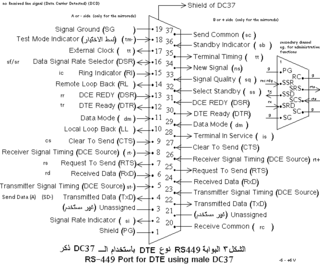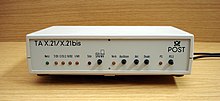
In telecommunications, RS-232 or Recommended Standard 232 is a standard originally introduced in 1960 for serial communication transmission of data. It formally defines signals connecting between a DTE such as a computer terminal, and a DCE, such as a modem. The standard defines the electrical characteristics and timing of signals, the meaning of signals, and the physical size and pinout of connectors. The current version of the standard is TIA-232-F Interface Between Data Terminal Equipment and Data Circuit-Terminating Equipment Employing Serial Binary Data Interchange, issued in 1997. The RS-232 standard had been commonly used in computer serial ports and is still widely used in industrial communication devices.
Bit-synchronous operation is a type of digital communication in which the data circuit-terminating equipment (DCE), data terminal equipment (DTE), and transmitting circuits are all operated in bit synchronism with a clock signal.
A data service unit, sometimes called a digital service unit, is a piece of telecommunications circuit terminating equipment that transforms digital data between telephone company lines and local equipment. The device converts bipolar digital signals coming ultimately from a digital circuit and directly from a Channel service unit (CSU), into a format compatible with the piece of data terminal equipment (DTE) to which the data is sent. The DSU also performs a similar process in reverse for data heading from the DTE toward the circuit. The telecommunications service a DSU supports can be a point-to-point or multipoint operation in a digital data network.
Isochronous burst transmission is a method of transmission. In a data network where the information-bearer channel rate is higher than the input data signaling rate, transmission is performed by interrupting, at controlled intervals, the data stream being transmitted.

X.25 is an ITU-T standard protocol suite for packet-switched data communication in wide area networks (WAN). It was originally defined by the International Telegraph and Telephone Consultative Committee in a series of drafts and finalized in a publication known as The Orange Book in 1976.

Data terminal equipment (DTE) is an end instrument that converts user information into signals or reconverts received signals. It is also called data processing terminal equipment or tail circuit. A DTE device communicates with the data circuit-terminating equipment (DCE), such as a modem. The DTE/DCE classification was introduced by IBM.

On computers, a serial port is a serial communication interface through which information transfers in or out sequentially one bit at a time. This is in contrast to a parallel port, which communicates multiple bits simultaneously in parallel. Throughout most of the history of personal computers, data has been transferred through serial ports to devices such as modems, terminals, various peripherals, and directly between computers.
Loopback is the routing of electronic signals or digital data streams back to their source without intentional processing or modification. It is primarily a means of testing the communications infrastructure.

In telecommunication and data transmission, serial communication is the process of sending data one bit at a time, sequentially, over a communication channel or computer bus. This is in contrast to parallel communication, where several bits are sent as a whole, on a link with several parallel channels.

RS-422, also known as TIA/EIA-422, is a technical standard originated by the Electronic Industries Alliance, first issued in 1975, that specifies electrical characteristics of a digital signaling circuit. It was meant to be the foundation of a suite of standards that would replace the older RS-232C standard with standards that offered much higher speed, better immunity from noise, and longer cable lengths. RS-422 systems can transmit data at rates as high as 10 Mbit/s, or may be sent on cables as long as 1,200 meters (3,900 ft) at lower rates. It is closely related to RS-423, which uses the same signaling systems but on a different wiring arrangement.

Null modem is a communication method to directly connect two DTEs using an RS-232 serial cable. The name stems from the historical use of RS-232 cables to connect two teleprinter devices or two modems in order to communicate with one another; null modem communication refers to using a crossed-over RS-232 cable to connect the teleprinters directly to one another without the modems. It is also used to serially connect a computer to a printer, since both are DTE, and is known as a Printer Cable.
A CSU/DSU is a digital-interface device used to connect data terminal equipment (DTE), such as a router, to a digital circuit, such as a Digital Signal 1 (DS1) T1 line. The CSU/DSU implements two different functions. The channel service unit (CSU) is responsible for the connection to the telecommunication network, while the data service unit (DSU) is responsible for managing the interface with the DTE. A CSU/DSU can have an external connection point or it can be integrated into a modular card installed in a router.

A crossover cable connects two devices of the same type, for example DTE-DTE or DCE-DCE, usually connected asymmetrically (DTE-DCE), by a modified cable called a crosslink. Such a distinction between devices was introduced by IBM.
In data communications, flow control is the process of managing the rate of data transmission between two nodes to prevent a fast sender from overwhelming a slow receiver. Flow control should be distinguished from congestion control, which is used for controlling the flow of data when congestion has actually occurred. Flow control mechanisms can be classified by whether or not the receiving node sends feedback to the sending node.

The RS-449 specification, also known as EIA-449 or TIA-449, defines the functional and mechanical characteristics of the interface between data terminal equipment, typically a computer, and data communications equipment, typically a modem or terminal server. The full title of the standard is EIA-449 General Purpose 37-Position and 9-Position Interface for Data Terminal Equipment and Data Circuit-Terminating Equipment Employing Serial Binary Data Interchange.
RS-423, also known as TIA/EIA-423, is a technical standard originated by the Electronic Industries Alliance that specifies electrical characteristics of a digital signaling circuit. Although it was originally intended as a successor to RS-232C offering greater cable lengths, it is not widely used.
Data Carrier Detect (DCD) or Carrier Detect (CD) is a control signal present inside an RS-232 serial communications cable that goes between a computer and another device, such as a modem. This signal is a simple "high/low" status bit that is sent from a data communications equipment (DCE) to a data terminal equipment (DTE), i.e., from the modem or other peripheral to a computer in a typical scenario. It is present on virtually all PC serial ports - pin 1 of a nine-pin (DE9) serial port, or pin eight over a 25-pin (DB25) port. Its purpose varies depending on the device connected, but the most specific meaning is to indicate when a modem is connected to another remote modem via telephone lines.
Data Terminal Ready (DTR) is a control signal in RS-232 serial communications, transmitted from data terminal equipment (DTE), such as a computer, to data communications equipment (DCE), for example a modem, to indicate that the terminal is ready for communications and the modem may initiate a communications channel.
In telecommunications, RS-366, later known as EIA-366, defines a standard for serial communications between computers and an auto dialer, which is used to dial telephones. It was intended to be used to automate the operation of modems. The standard uses the same DB25 connectors and electrical signalling standards of the well-known RS-232 standard, which RS-366 was designed to support. The CCITT had a matching standard, V.25.










